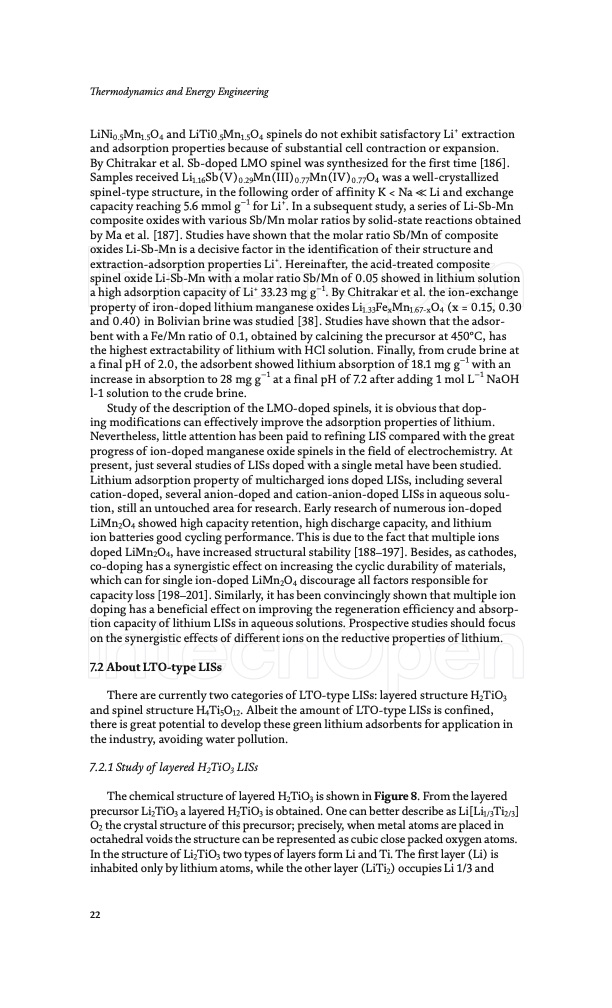
PDF Publication Title:
Text from PDF Page: 024
Thermodynamics and Energy Engineering LiNi0.5Mn1.5O4 and LiTi0.5Mn1.5O4 spinels do not exhibit satisfactory Li+ extraction and adsorption properties because of substantial cell contraction or expansion. By Chitrakar et al. Sb-doped LMO spinel was synthesized for the first time [186]. Samples received Li1.16Sb(V)0.29Mn(III)0.77Mn(IV)0.77O4 was a well-crystallized spinel-type structure, in the following order of affinity K < Na ≪ Li and exchange capacity reaching 5.6 mmol g−1 for Li+. In a subsequent study, a series of Li-Sb-Mn composite oxides with various Sb/Mn molar ratios by solid-state reactions obtained by Ma et al. [187]. Studies have shown that the molar ratio Sb/Mn of composite oxides Li-Sb-Mn is a decisive factor in the identification of their structure and extraction-adsorption properties Li+. Hereinafter, the acid-treated composite spinel oxide Li-Sb-Mn with a molar ratio Sb/Mn of 0.05 showed in lithium solution a high adsorption capacity of Li+ 33.23 mg g−1. By Chitrakar et al. the ion-exchange property of iron-doped lithium manganese oxides Li1.33FexMn1.67-xO4 (x = 0.15, 0.30 and 0.40) in Bolivian brine was studied [38]. Studies have shown that the adsor- bent with a Fe/Mn ratio of 0.1, obtained by calcining the precursor at 450°C, has the highest extractability of lithium with HCl solution. Finally, from crude brine at a final pH of 2.0, the adsorbent showed lithium absorption of 18.1 mg g−1 with an increase in absorption to 28 mg g−1 at a final pH of 7.2 after adding 1 mol L−1 NaOH l-1 solution to the crude brine. Study of the description of the LMO-doped spinels, it is obvious that dop- ing modifications can effectively improve the adsorption properties of lithium. Nevertheless, little attention has been paid to refining LIS compared with the great progress of ion-doped manganese oxide spinels in the field of electrochemistry. At present, just several studies of LISs doped with a single metal have been studied. Lithium adsorption property of multicharged ions doped LISs, including several cation-doped, several anion-doped and cation-anion-doped LISs in aqueous solu- tion, still an untouched area for research. Early research of numerous ion-doped LiMn2O4 showed high capacity retention, high discharge capacity, and lithium ion batteries good cycling performance. This is due to the fact that multiple ions doped LiMn2O4, have increased structural stability [188–197]. Besides, as cathodes, co-doping has a synergistic effect on increasing the cyclic durability of materials, which can for single ion-doped LiMn2O4 discourage all factors responsible for capacity loss [198–201]. Similarly, it has been convincingly shown that multiple ion doping has a beneficial effect on improving the regeneration efficiency and absorp- tion capacity of lithium LISs in aqueous solutions. Prospective studies should focus on the synergistic effects of different ions on the reductive properties of lithium. 7.2 About LTO-type LISs There are currently two categories of LTO-type LISs: layered structure H2TiO3 and spinel structure H4Ti5O12. Albeit the amount of LTO-type LISs is confined, there is great potential to develop these green lithium adsorbents for application in the industry, avoiding water pollution. 7.2.1 Study of layered H2TiO3 LISs The chemical structure of layered H2TiO3 is shown in Figure 8. From the layered precursor Li2TiO3 a layered H2TiO3 is obtained. One can better describe as Li[Li1/3Ti2/3] O2 the crystal structure of this precursor; precisely, when metal atoms are placed in octahedral voids the structure can be represented as cubic close packed oxygen atoms. In the structure of Li2TiO3 two types of layers form Li and Ti. The first layer (Li) is inhabited only by lithium atoms, while the other layer (LiTi2) occupies Li 1/3 and 22PDF Image | Lithium Recovery from Seawater Salt Lake Brine

PDF Search Title:
Lithium Recovery from Seawater Salt Lake BrineOriginal File Name Searched:
IntechOpenSamadiyBookchapter.pdfDIY PDF Search: Google It | Yahoo | Bing
Product and Development Focus for Infinity Turbine
ORC Waste Heat Turbine and ORC System Build Plans: All turbine plans are $10,000 each. This allows you to build a system and then consider licensing for production after you have completed and tested a unit.Redox Flow Battery Technology: With the advent of the new USA tax credits for producing and selling batteries ($35/kW) we are focussing on a simple flow battery using shipping containers as the modular electrolyte storage units with tax credits up to $140,000 per system. Our main focus is on the salt battery. This battery can be used for both thermal and electrical storage applications. We call it the Cogeneration Battery or Cogen Battery. One project is converting salt (brine) based water conditioners to simultaneously produce power. In addition, there are many opportunities to extract Lithium from brine (salt lakes, groundwater, and producer water).Salt water or brine are huge sources for lithium. Most of the worlds lithium is acquired from a brine source. It's even in seawater in a low concentration. Brine is also a byproduct of huge powerplants, which can now use that as an electrolyte and a huge flow battery (which allows storage at the source).We welcome any business and equipment inquiries, as well as licensing our turbines for manufacturing.| CONTACT TEL: 608-238-6001 Email: greg@infinityturbine.com | RSS | AMP |